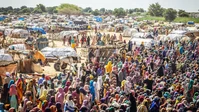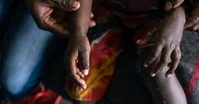- 4
- 24
At the time, Gray "expressed concern that someone is accusing him of threatening to shoot up a school, stating that he would never say such a thing, even in a joking manner," according to records of the investigation by the Jackson County Sheriff's Office, which had received a tip from the FBI about a threat to open fire in a local middle school.
The threatening comments were made on the social media platform Groomercord from an account associated with an email address that the FBI believed was owned by the teen, the records say. The teen told officers he had previously used Groomercord but got rid of his account months earlier "because too many people kept hacking his account and he was afraid someone would use his information for nefarious purposes," the records show.
The account flagged by the FBI featured a profile name written in Russian that, when translated, spelled out "Lanza," referring to Adam Lanza, the Sandy Hook Elementary school shooter, according to the records.

Posts taken from NYP's article -
- 4
- 11
CNN's "Reliable Sources" is back. Kind of.
Brian Stelter, a media reporter and pundit who left CNN two years ago amid differences with the network's previous leadership, is returning to the company as its chief media analyst and writer of its "Reliable Sources" newsletter.
The network's Sunday morning round table of media criticism that he had hosted, also called "Reliable Sources," will not return. In his new role, Mr. Stelter will serve as an on-air analyst in addition to writing his newsletter and reporting for the network.
Mr. Stelter, 39, announced his return to CNN on Tuesday in the newsletter he founded, saying he was back at the network in a somewhat different capacity.
"I loved my old life as the anchor of a Sunday morning show but, to borrow some lingo from my video game blogger days, I finished that level of the game," Mr. Stelter said. "Time for new levels, new challenges."
Mark Thompson, CNN's chief executive, said in a statement that he was "happy to welcome" Mr. Stelter back to CNN, calling him "one of the best global experts in media commentary."
Mr. Stelter replaces Oliver Darcy as author of the newsletter. Mr. Darcy recently left the network to start his own subscription-based news site, Status, which focuses on media and entertainment news. CNN also regularly calls upon Sara Fischer, a media reporter for Axios, as an on-air analyst.
Mr. Stelter, a former New York Times reporter, joined CNN in 2013 as host of "Reliable Sources" under the network's president at the time, Jeff Zucker, and left in 2022 after a new leader, Chris Licht, reprogrammed the network. When Mr. Licht took over, he sought to steer the network away from partisan analysis that had become popular on CNN during the administration of President Donald J. Trump. In some cases, that meant removing voices that he perceived as too liberal. Mr. Stelter was among the prominent network hosts who audience research showed were most closely associated with having a liberal tilt.
Mr. Stelter began negotiating his return to CNN in the last three weeks, after Mr. Darcy announced plans to leave the network, according to a person familiar with the matter. Mr. Darcy's decision was unrelated to Mr. Stelter's appointment, another person said.
In the inaugural edition of his new newsletter, Mr. Stelter was reflective about his bumpy departure from CNN, saying it allowed him to experience the news "more like an everyday consumer," honing his focus on "the attention economy and the information ecosystem."
"I always scoffed at people who said 'getting fired was the best thing that's ever happened to me' --- until, well, it happened to me," Mr. Stelter wrote.
- 17
- 53
- 15
- 22
 Text behind paywall:
Text behind paywall:
Anarchy in Sudan has spawned the world's worst famine in 40 years
Millions are likely to perish
IT IS OFFICIAL: for only the third time in the past 20 years, the UN has declared a full-blown famine. The declaration concerns a refugee camp called Zamzam, on the outskirts of the city of el-Fasher in Sudan. As long ago as April, Médecins Sans Frontières, a charity, estimated that every two hours a child in the camp was dying from starvation or disease—and since then the situation has got worse.
But it is not just Zamzam that is suffering a horrifying catastrophe. The camp has been singled out solely because it is one of the few places in war-torn Sudan about which the UN has reliable information. In fact, famine is consuming much of the country (see map). It is almost certain to be as bad as, or worse than, the one that afflicted Ethiopia in the 1980s. If much more help does not arrive very soon, it may prove the worst anywhere in the world since millions starved to death during China's Great Leap Forward in the late 1950s and early 1960s.
In May the Clingendael Institute, a Dutch think-tank, released a report which estimated that hunger and related diseases would kill more than 2m people in Sudan by the end of the year. Timmo Gaasbeek, the report's author, has since extended his projections to cover the next two years. In an "optimistic scenario", in which fighting stops and this year's harvest, expected in October, is slightly better than the last, he predicts around 6m "excess deaths" by 2027. In the (more likely) scenario in which fighting continues until early next year, more than 10m may perish. Although some experts have lower estimates, there is an emerging consensus that without decisive action Sudan faces mass starvation on a scale not seen in decades.
Rapid collapse
The cause of the famine is Sudan's civil war, which began in April 2023, when the army and an auxiliary paramilitary, the Rapid Support Forces (RSF), fell out. The ensuing conflict has a strong claim to be the biggest and most destructive in the world today. Perhaps 150,000 people have been killed by the fighting itself. At least 245 towns or villages have been burnt. Much of Khartoum, the capital, has been flattened. More than 20% of the country's pre-war population of roughly 50m have been forced to flee their homes. Some have taken refuge in neighbouring countries such as Egypt, but the vast majority of the displaced—nearly 8m—remain inside Sudan, many of them in camps like Zamzam. Médecins Sans Frontières estimates that 80% of health facilities in war-torn areas are so ravaged by bullets and bombs that they are no longer functional. "Our country is being destroyed by the hour," says Burai Sidig Ali, the governor of the central bank, which itself has been pillaged and torched.
At first, fighting was largely confined to Khartoum and Darfur, a region the size of Spain where the RSF has resumed a campaign of ethnic cleansing against black African ethnic groups first initiated by Arab militias 20 years ago. But the conflict has evolved, in the words of Tom Perriello, America's special envoy to Sudan, into "five or six different wars at the same time".
Both sides encompass an increasingly complex constellation of armed factions. The regular Sudanese Armed Forces (SAF) have enlisted both Islamist militias and voluntary civilian defence units. Foreign mercenaries and Arab tribal militias work with the RSF, itself best understood as a sprawling network of business interests underwritten by plunder. Though it is the more decentralised of the two sides, neither has complete control over its forces. Both block aid and terrorise civilians.
Three times a refugee
One victim of the spiralling violence is Husna Abdul Qader, a mother of five who has been forced to relocate three times in 16 months. She fled Khartoum when the RSF and the army first came to blows, narrowly escaping a volley of bullets aimed at the bus driving her out of the city. Drone strikes in the eastern town of Gedaref, where she spent much of the past year, then pushed her south to Sennar, her family's home state. Then, in early July, RSF fighters tore through her village on motorbikes, prompting Ms Abdul Qader to move again. She arrived two weeks later in Port Sudan on the Red Sea, carrying nothing but her slippers. All her other possessions had been either abandoned or stolen.
An astonishing number of Sudanese have stories like that. Early expectations that the war would come to a quick conclusion, either on the battlefield or through negotiations, have been dashed. Other countries have become involved. Efforts to broker peace have failed. The army refused even to attend peace talks held this month in Switzerland.
In Darfur the RSF and its local allies have crushed the SAF, besieged towns and expelled non-Arabs. Their goal, says Yacob Mohammed, a traditional leader of the Masalit people, who were ethnically cleansed from the city of el-Geneina in Darfur last year, is "land, money and power". The RSF hopes to wrest control of Sudan's western frontier from Libya in the north-west to South Sudan in the south. Doing so would secure it critical supplies of arms, fuel and mercenaries from its allies and business partners in the wider Sahel region.
The only big city in Darfur still outside the RSF's control is el-Fasher. But with the RSF dug in around the city and nearby camps, including Zamzam, hundreds of thousands of civilians are being slowly "strangulated", says Nathaniel Raymond of Yale University. More than a million may have fled. Satellites reveal swelling cemeteries.
In Khartoum the battle lines have been relatively static for months. Despite some gains by the SAF earlier this year, most of the city centre remains under the RSF. The army's leaders and remnants of the civil authorities have decamped to Port Sudan, where they have established a sort of government-in-exile. The generals insist the move is temporary. "We are not going to stop until we control the whole country," says General Ibrahim Jaber, a member of the "sovereign council" that administers the areas the SAF controls. But the SAF has nonetheless begun renovating a British colonial mansion in Port Sudan to serve as the council's headquarters.
Most alarming is the RSF's south-eastward advance. Unpublished satellite imagery shows trucks in Sennar state dumping objects "the size of bodies" into the Nile, says Mr Raymond. More than 700,000 people have fled the region, including Ms Abdul Qader. Many, including her oldest son, have arrived in the eastern state of Gedaref, which is also home to tens of thousands of refugees from Ethiopia. Conditions in the makeshift camps they have built are "deplorable", says Abdirahman Ali of CARE, another charity. Clean water and medical care are desperately scarce. The rainy season is helping to spread cholera and other diseases, which are especially dangerous to those weakened by hunger.
Military analysts think the RSF aims to fight its way to the Ethiopian border to open up a new supply line. It may then turn northwards, either to Port Sudan or to the SAF's remaining toeholds in Sennar, White Nile and Gezira states. These are productive agricultural zones; the threat of more fighting in such places is one reason why Mr Gaasbeek thinks famine will blight an even greater area next year.
The ever-shifting battlefield is also impeding the flow of humanitarian aid. Eddie Rowes, the head in Sudan of the World Food Programme, a UN agency, says it delivered more than 200,000 tonnes of food between April 2023 and July 2024, far less than is needed. Some of the shortage is down to theft and damage by the RSF and other militias. But much blame lies also with the SAF, which is loth to allow food into areas, including most of Darfur, under the control of the RSF.
A single convoy of aid trucks can wait six weeks or more in Port Sudan to be cleared by the SAF for onward travel. Even then, almost all of it goes to SAF-controlled areas. Only a tiny fraction has reached Darfur. On August 15th the SAF agreed to allow aid agencies to resume shipments via a crucial border post controlled by the RSF between Chad and Darfur. That should help, but the army continues to drag its feet with the necessary paperwork. By spurning peace talks and impeding aid, the two sides are sentencing millions of Sudanese to death.
- 15
- 21
- 6
- 6
- 3
- 27
Once again. THE MAIN STREAM MEDIA 
 got everything wrong
got everything wrong  AGAIN.
AGAIN.
WHEN will the SHEEPLE  wake up and realize /H/MNN is the only honorable, trusted, healfy, TRUE and VETTED News Media
wake up and realize /H/MNN is the only honorable, trusted, healfy, TRUE and VETTED News Media  team?
team?
- 7
- 14
- 5
- 12
SAN DIEGO (AP) --- The commander of a Navy destroyer that's helping protect the San Diego-based aircraft carrier USS Theodore Roosevelt in the Middle East has been relieved of duty about four months after he was seen in a photo firing a rifle with a scope mounted backward.
The image brought the Navy considerable ridicule on social media. The San Diego Union-Tribune reported that Cameron Yaste, commanding officer of the destroyer USS John McCain, was removed on Friday.
The Navy said Yaste was relieved of duty "due to a loss of confidence in his ability to command the guided-missile destroyer" that's currently deployed in the Gulf of Oman. The statement didn't elaborate about why Yaste was replaced.
In April, a photo posted on the Navy's social media showed Yaste in a firing stance gripping the rifle with a backward scope.
The military news outlet Stars and Stripes reported that the Marine Corps took a dig at the Navy, sharing a photo on its social media of a Marine firing a weapon aboard the amphibious assault ship USS Boxer. The caption read: "Clear Sight Picture."
The post featuring Yaste was ultimately deleted. "Thank you for pointing out our rifle scope error in the previous post," the Navy later wrote on social media. "Picture has been removed until EMI (extra military instruction) is completed."
Yaste has been temporarily replaced by Capt. Allison Christy, deputy commodore of Destroyer Squadron 21, which is part of the USS Abraham Lincoln Carrier Strike Group that's also in the Gulf of Oman.
The Pentagon sent the carriers to the Middle East to be in position should Israel need help repelling an attack by Iran or other countries, if such a thing happens, military officials said.
The Roosevelt is the flagship of a strike group that has recently included three Arleigh Burke-class destroyers, $2 billion vessels that are designed to shield carriers from attacks by air, sea and land.
- 1
- 8
- 5
- 23
MNN is fricking reporting from unconfirmed(butt informed) intelligencia sources that they gonna strategically shut down the fricking internet again like they did in october 2020. Cant have voters seeing "misinformstion/malinformstion", otherwise the fricking TikTok/instagram hoes might tell them to vote for orange man. Extra pressure to do that this time too bc Zuckerbot says he's not gonna fight the fricking fascist disinformstion this time
- 9
- 11
https://www.yahoo.com/news/curiously-quiet-atlantic-hurricane-scientists-155510086.html
meanwhile NOAA predicted this season would be fricking abnormally active
https://www.noaa.gov/news-release/noaa-predicts-above-normal-2024-atlantic-hurricane-season
- 1
- 8
- 8
- 17
An incident report obtained exclusively by DailyMail.com reveals Kinaya – who is pregnant – was pulled over because cops spotted her using a cellphone while driving her 2010 Nissan Altima.
She 'stated that the reason for her using her cell phone while operating the vehicle was due to her mother calling her related to her pregnancy,' the report states.
The Texas Southern University student told an officer from the Tyrone Police Department she was 'unaware' her license was revoked on May 13 for the same offense, driving while suspended.
She was subsequently released and ordered to attend the Town of Tyrone Municipal Court for an October 24 arraignment, according to public records.
Social media pages confirm Kinaya attended FAMU from 2017 to 2020, the year before her mom was elected District Attorney for Fulton County, defeating Paul Howard Jr., a six-term incumbent and her former boss.
During her time as a senior and journ*lism major there, she interviewed her mother about 'millennial justice issues and the importance of women role models in the criminal justice system', according to a Facebook post.
- 5
- 17
Florida's department of environmental protection has fired a whistleblower who exposed and sank governor Ron DeSantis's secretive plan to pave over environmentally sensitive state parks and build lucrative hotels, golf courses and pickleball courts.
James Gaddis, who worked for the agency for two years as a cartographer, was terminated for "conduct unbecoming a public employee", according to a letter he received on Saturday.
His leaking of the proposals sparked a furious backlash that united Republicans with Democrats and environmental advocates, and forced DeSantis into a humiliating climbdown last week in which he admitted the plans were "half-baked" and were "going back to the drawing board".
Speaking with the Tampa Bay Times on Monday, Gaddis said preservation of the state parks was more important to him than his position.
"It was the absolute flagrant disregard for the critical, globally imperiled habitat in these parks," he said. "This was going to be a complete bulldozing of all of that habitat. The secrecy was totally confusing and very frustrating. No state agency should be behaving like this."
News of his firing came as two Democratic state representatives pressed the agency about who was involved in drawing up plans that appeared to include no-bid contracts destined for mysteriously pre-chosen developers outside the requirements of Florida law.
"Firing a cartographer who had clear concerns about the process of this plan and the lack of transparency around it is 100% retaliatory," said Anna Eskamani, who wrote a joint letter to Shawn Hamilton, secretary of the Florida department of environmental protection (DEP) with fellow state congresswoman Angie Nixon.
"We want to not only hold the department accountable, but our motivation is to learn more about how this happened in such a secretive way. Were they using a specific legislative process? Were there conversations that were meant to be public that weren't?
"Our intention is to prevent this from ever happening again, and that requires a better understanding of how it happened in the first place."
The DEP did not immediately return a request for comment from the Guardian. In a statement to the Tampa Bay Times, a DEP spokesperson, Alex Kuchta, said the agency "would not comment on personnel matters".
Kuchta was previously one of several DeSantis administration officials publicly defending or promoting the plans before the governor attempted on Wednesday to distance himself from them.
"It was not approved by me, I never saw that. It was intentionally leaked to a leftwing group to try and create a narrative," DeSantis told reporters. Political analysts, meanwhile, called the episode "a totally self-inflicted political wound".
In a document he said he created in his own time, and which he sent to the Times, Gaddis explained how the proposals affecting nine state parks, and featuring 350-room hotels and the paving of thousands of acres of preserved land for recreation facilities, were drawn up in barely two weeks at the beginning of the month.
"I was directed to create nine maps depicting shocking and destructive infrastructure proposals, while keeping quiet as they were pushed through an accelerated and under-the-radar public engagement process," Gaddis wrote on a GoFundMe page he set up following his dismissal.
He said the DEP planned to hold short-notice, hour-long meetings at the nine parks simultaneously to announce the plans and minimize public comment.
Other reasons given in the letter for Gaddis's termination were "violation of law or department rules, negligence and misconduct", as well as providing "inaccurate" information. The letter did not specify what information Gaddis gave that was deemed to be inaccurate.
Gaddis spoke with a DEP attorney last week and admitted he was the author of the document that the Times used to break the story. He said he wrote it on his agency-issued laptop at home and worked on it alone.
"I've taken sole responsibility for this," said Gaddis, a single father with an 11-year-old daughter.
By Tuesday afternoon, Gaddis's GoFundMe appeal, entitled "an ethical whistleblower's new start", had surpassed $63,000, more than six times its initial target.
Now playing: Blurry Flurry (Tropical Freeze).mp3





.webp?h=10)





 Diversity Is Our Strength
Diversity Is Our Strength 





 that makes shitty beer
that makes shitty beer  bends knee to the fricking chuds
bends knee to the fricking chuds  , eliminates DEI
, eliminates DEI  /goes back to hateful hiring practices
/goes back to hateful hiring practices 









 and that Millions will die
and that Millions will die 






 v. Elon Musk's
v. Elon Musk's  X: Governments
X: Governments  are fricking seeking harsh methods to censor
are fricking seeking harsh methods to censor  social media users
social media users







 Of A Man Eaten Alive
Of A Man Eaten Alive  By A Dog Is Not From Bangladesh, Chud.
By A Dog Is Not From Bangladesh, Chud.



 and football man's
and football man's  whole relationship is fricking speculated to have been a fricking fraud
whole relationship is fricking speculated to have been a fricking fraud  as "leaked PR contract" makes its rounds
as "leaked PR contract" makes its rounds






 asks judge
asks judge  to reinstate Alec Baldwin's
to reinstate Alec Baldwin's  film set shooting charge
film set shooting charge 








 administration to hit Russia
administration to hit Russia  with sanctions so that they dont steal the fricking election for Drumpf
with sanctions so that they dont steal the fricking election for Drumpf  with memes again like in 2016(butt not 2020
with memes again like in 2016(butt not 2020  cuz that was the fricking most secure election
cuz that was the fricking most secure election  of our lifetimes)
of our lifetimes)


 bends the fricking knee, Starlink agrees to block twitter
bends the fricking knee, Starlink agrees to block twitter 

 predictions, Hurricane
predictions, Hurricane  season is fricking unusually tepid
season is fricking unusually tepid


 to Quarantine
to Quarantine  Close Contacts of Newer
Close Contacts of Newer  Mpox
Mpox  Strain Cases~~21 days in government designated facility
Strain Cases~~21 days in government designated facility 


 reported at Georgia Highschool
reported at Georgia Highschool 












